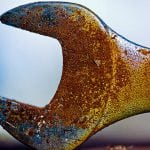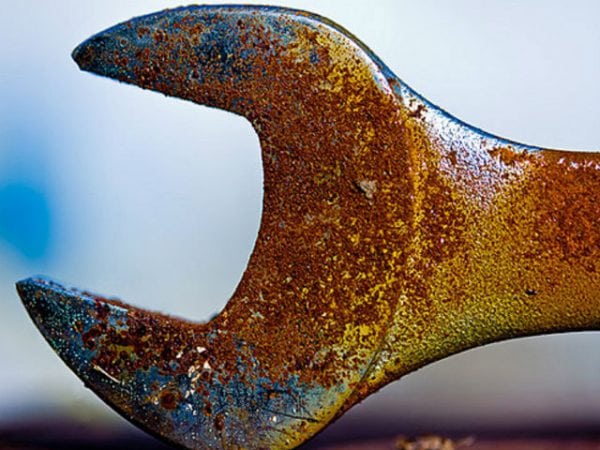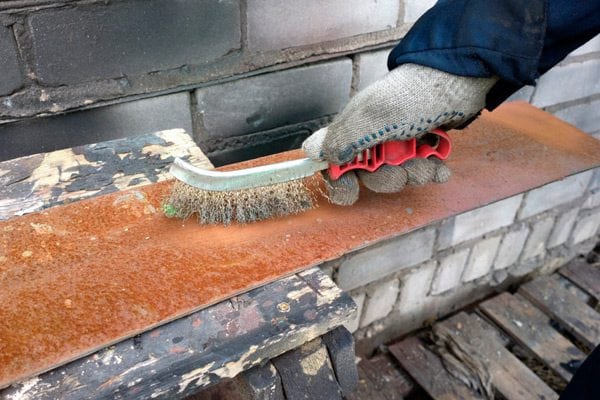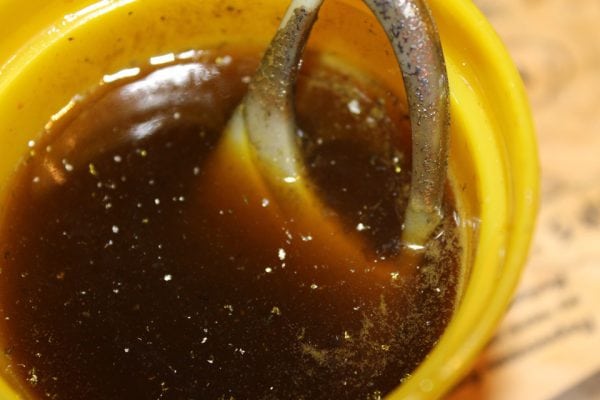All metals rust. Even aluminum (including food) with a long stay in a humid environment forms a strong oxide film on its surface. Therefore, effective rust removal is a problem that sooner or later any owner has to face.
- Types and effects of corrosion on the performance of household items and tools
- Classification of ways to combat corrosion
- Mechanical cleaning methods
- Thermal cleaning of steel surfaces
- Chemical cleaning

Types and effects of corrosion on the performance of household items and tools
The rust formed under ordinary conditions is actually a mixture of three iron oxides, which are not formed simultaneously and possess different physical and mechanical properties. Starting from the bottom, and further to the surface, the composition of steel rust is a combination of the following components:
- Wustite FeO (iron oxide) is a rather soft substance with a layer thickness depending on the conditions in which the metal object was stored. At elevated temperatures, the wustite layer is always larger.
- Magnetite Fe3O4 (magnetic iron ore) is a magnetic oxide-iron oxide, the hardness of which is less and the porosity is greater than that of wustite. Magnetite has pronounced magnetic properties.
- Hematite Fe2O3 (red iron ore) is a reddish-gray solid abrasive substance that is firmly held to the surface. Hematite is characterized by increased density, corrodes steel and significantly increases the coefficient of friction during any interaction of the contacted surfaces with each other.
The problem with rust removal is that it is initially unknown when and how soft and ductile magnetite will transfer to hematite. Therefore, it is required to know not only the composition of the metal surface, but also the conditions under which rust spots appeared on it. Knowing such details, you can choose the best method of removing oxide and the most effective anti-rust agents.
to contents ↑
Classification of ways to combat corrosion
Based on the properties of the main components of rust, we can distinguish the following methods for its removal:
- mechanical, in which the oxide layer is removed using hard steel brushes;
- thermal, in which the effect of rust on elevated temperatures is used (usually in combination with intense air or water flow);
- chemical - the result of a reaction initiated by a special agent (rust solvent) applied to the surface of a metal object.
The effectiveness of these methods is different. For example, with the timely detection of a small spot of rust, the surface can be easily cleaned with a steel brush or emery coarse sandpaper. In the case when the rust was detected inopportune, chemical cleaning is more suitable.
to contents ↑For bulky surfaces that are difficult to move or transport, heat treatment, although laborious, is the only effective way to remove corrosion. Often, methods and compositions for metal purification are combined and implemented in a certain sequence.
Mechanical cleaning methods
The choice of a specific cleaning method is determined by the type of metal surface being cleaned.For example, for a long-stored coil of steel wire, you can apply its periodic rewinding from one pair of rollers to another. In the process of such kinks, peeling occurs first, and then the scale is separated from the metal surface.
After such rewinding, it is better to pass the wire between a pair of hard steel brushes at the end, with the help of which the final separation of rust from the base metal takes place. Removing rust in this way is also possible if, instead of brushes, sandpaper or coarse paper is used.
The disadvantage of this method is that after processing on the cleaned surface there are traces of the cleaning tool.
to contents ↑After mechanical cleaning, metal products should be polished, especially if the surface to be treated must retain its previous appearance.
Thermal cleaning of steel surfaces
To implement this method, an industrial steam generator or, in extreme cases, a building hair dryer is required. In this case, the purification is based on the fact that the connection of the scale of any chemical composition with the base metal is relatively small. Therefore, exposure to temperature, moisture, changes in air velocity will help remove surface rust.
The most effective cleaning by this method occurs if the surface to be treated is placed at a certain distance from the unit and the supply of heated steam is turned on. The jet of steam-air mixture, supplied under pressure, first softens the scale, and then crushes it into individual fragments, which are subsequently easily removed by air flow.
In this way, rust can be removed from the surface of a steel door, ventilation duct, other metal objects, the dismantling of which is either difficult or completely impossible.
to contents ↑
Chemical cleaning
The arsenal of methods and compositions of chemical treatment is the most diverse. Corrosion is removed chemically by exposure to oxides with acid solutions.
- The most effective means is hydrochloric acid, especially the corresponding concentration of at least 15% (at a lower concentration, the dissolution does not stop, but noticeably slows down).
- The use of sulfuric acid-based formulations is not recommended, since as a result a layer of iron hydrides is formed on the cleaned surface, increasing the fragility of the product. This layer can not be cleaned: in a day this chemical compound will decay on its own under the influence of moisture contained in the air. However, this is sometimes unacceptable.
- At home, to eliminate rust from small surfaces, you can take vinegar, lemon, even Coca-Cola. The principle of operation is the same - we immerse the object in acid and leave it for a while, then clean it.
The etching performance is also affected by the temperature of the solution: with its increase, removing the rust will turn out much faster.
The etched surface must be neutralized from acid residues - rinse under a warm soapy solution, and then thoroughly clean or dry in calm air.
Etching is an environmentally harmful process: care must be taken to ensure that the remnants of the used product do not get on food products, protect their hands from the corrosive effects of reagents, etc. Therefore, the fluid with which rust can be effectively removed must be non-toxic. As an alternative to acid etching, the following methods can be used:
- Electrolytic etching in a solution of ferric chloride. This composition is non-toxic and available for purchase. Cleaning is carried out by immersing the product with rust in a solution of ferric chloride, while connecting one of the electrodes to the bath with the solution, and the second to the item being cleaned.The voltage during electrolytic etching is small - no more than 12 V, so the technology is completely safe. In the absence of ferric chloride, you can use any household alkali, in particular, caustic soda. Depending on the required cleaning intensity, the process can be continued for 3-15 minutes.
- Application of a special cleaner to the metal surface, which includes borax, lime, and rust converters. The mechanism of action of such a substance suggests that its components penetrate the sublayer part of the rust, soften and then convert it to flakes, which are already easily removed by a stream of warm water.
The choice of the optimal method for cleaning metal from rust depends on the size of the item, the availability of tools and equipment. A well-cleaned surface needs to be primed in the future, and it is ready for painting.






